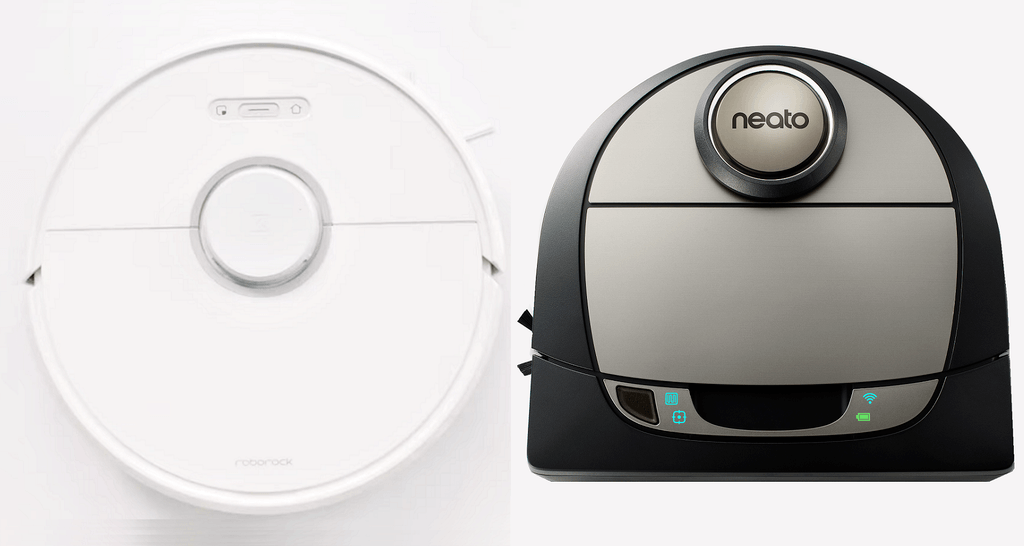If you are in the market for a new robot vacuum, you have no doubt heard of Roborock. You are also aware of Neato and how they continuously battle Roomba for the top spot in the industry. With the release of the Roborock S6, though, should Neato worry about a new competitor?
This review will showcase the Roborock S6 vs. Neato D7 to find out not only which one is a better machine, but also to help you decide which is a better machine for you. In the end, it could go either way, but the Roborock is a more economical choice. Find out why below.
Contents
- 1 Differences between Roborock S6 and Neato D7
- 2 Similarities between Roborock S6 and Neato D7
- 3 Specifications Chart
- 4 Comparing the Roborock to the Neato
- 5 Frequently Asked Questions
- 5.1 Q. What type of warranty does the Roborock S6 have?
- 5.2 Q. What type of warranty does the Neato D7 offer?
- 5.3 Q. How do I contact Roborock customer service?
- 5.4 Q. Can I contact Neato customer service?
- 5.5 Q. Where is the best place to buy a Roborock or Neato?
- 5.6 Q. What accessories will I need for these two robot vacuums?
- 6 What I Like About the Roborock S6
- 7 What I Like About the Neato D7
- 8 Conclusion
Differences between Roborock S6 and Neato D7
It should come as no surprise that there are plenty of differences between the two models. What matters, though, is how they affect you. Let’s take a look.
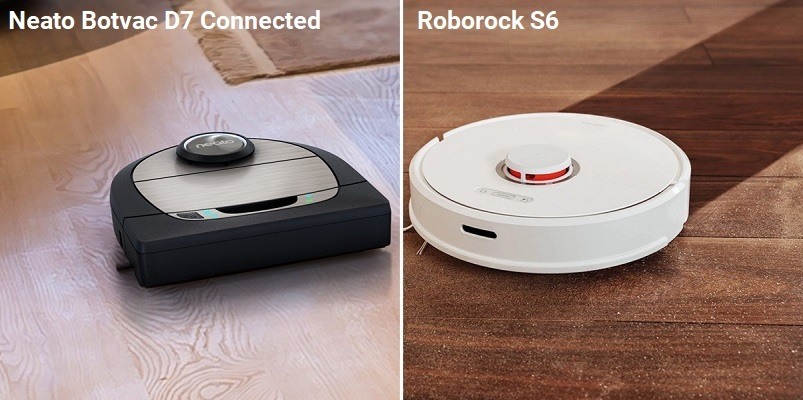
- The Roborock S6 can perform a wet mop, while the Neato D7 only vacuums.
- Battery capacity. Neato has a moderate battery capacity and performance with 3300mAh powering the robot for up to 2 hours. The S6 uses a 5200mAh battery with a runtime over 4 hours.
- Collection bin. You will have to empty the Roborock bin more frequently as it has a smaller capacity than the Neato robot.
- Neato offers multiple containment methods, including physical and digital, where the Roborock only has digital containment.
- Noise level. The Roborock S6 is much quieter than the Neato D7.
- Warranty period. Roborock doubles the warranty period (2-years) of the Neato D7 (1-year).
- Robot shape. The Neato D7 has a D-shape that fits into corners. The Roborock S6 is the standard round shape.
Similarities between Roborock S6 and Neato D7
As with all robotic cleaners, there are bound to be similarities. These two models share a lot in common. Have a look.
- Recharge and Resume. Both robots will automatically recharge their batteries when they get low and return to where they left off to resume cleaning.
- Wireless communications. You can use each model’s respective mobile app or Alexa voice commands for added control.
- HEPA filtration. The S6 and D7 both come with HEPA quality filtration to help lower in-home allergens.
- Neato and Roborock both use laser-guided navigation (LIDAR) to maneuver through your home and create a map for navigation.
- Floor types. Each robot is rated to clean all floor types.
- You will find combination brush rollers on both models to sweep floors and agitate carpet fibers.
Specifications Chart
Let’s take a look at the two robots and their features side-by-side to get a better understanding of what they offer.
| Neato D7 | Roborock S6 | |
| Dimensions | 13.21×12.56×3.92 inches | 13.7×13.8×3.8 inches |
| Weight | 7.5 pounds | 7.7 pounds |
| Battery | 3300mAh Lithium-ion | 5200mAh lithium-ion |
| Runtime | 120 minutes | Up to 150 minutes |
| Charge Time | 4 hours | 5 hours |
| Automatic Recharge | Yes | Yes |
| Automatic Resume | Yes | Yes |
| Filter | Neato Ultra | E-11 HEPA, washable |
| Motor Suction | Up to 2100pa | Up to 2000pa |
| Scheduling | Yes | Yes |
| Spot Cleaning | Yes | Yes |
| Real Time Location and Programming | Yes | Yes |
| Wireless Communications | Yes | Yes |
| Local Controls | Yes | Yes |
| Mobile App | Yes | Yes |
| Voice Commands | Yes | Yes |
| Navigation | LIDAR | Multi-Sensor Multi-Room |
| Mapping | LDS | LDS |
| Collection Bin Capacity | 0.7L | 0.5L |
| Water Reservoir Capacity | N/A | 0.15L |
| Noise Level | 60dB | 50dB |
| Adjustable Water Level | N/A | Yes |
| Select Room Navigation | No | Yes |
| Select Room Scheduling | No | Yes |
| Multiple Maps Stored | No | Yes (3 maps) |
| Containment | Digital & Magnetic Tape | Yes (app only) |
| Side Brush | 1 | 1 |
| Floor Types | All | All |
| Sensors | 8 | 14 |
| Dry Mop | No | No |
| Damp Mop | No | Yes |
| Wet Mop | No | Yes |
| Warranty | 1 Year | 2 years |
| Price | Check on Amazon | Check on Amazon |
Comparing the Roborock to the Neato
Forget the lab; let’s take these two robots out into the real world and find out how they really work. This section will help you understand what to expect when you get the robots home and put them to work.
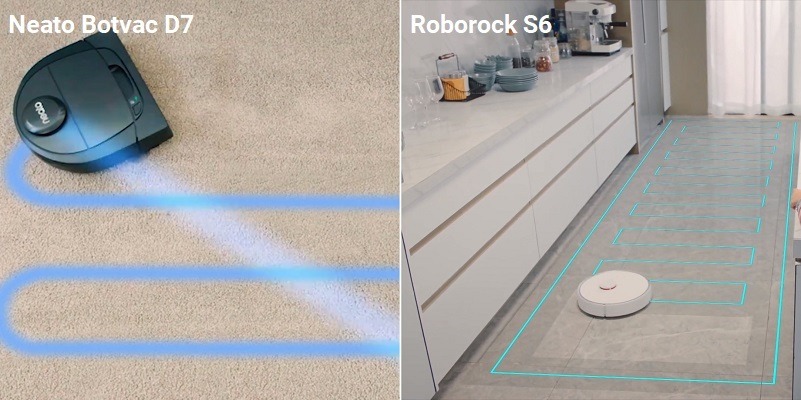
Both robots use the LIDAR style of navigation and mapping. LIDAR is a laser-guided system that scans your ceilings as the robot moves around the rooms. The Laser makes not of the distance between door frames and wall corners, ceiling lights or fans, and other objects to determine the size and shape of the room.
As the robot moves around, it also uses onboard sensors to determine where in the room things like furniture and obstacles are. Once a mapping run is finished, the robot has a perfect layout of your home, which is stored in the memory and displayed on the mobile app.
The result for both robots is about the same. However, Neato has a better algorithm for figuring distances and needs less mapping runs to complete the entire floor plan. Roborock usually needs about 4 or 5 runs to make a full map. However, Roborock can also map and store 3 different floor plans in its memory; Neato only does one map at a time.
Bottom Line: Roborock gets a slight edge for being able to map more floor plans overall, but the process and results are the same.
Recharge and Resume
When the battery level drops below 15%, the Neato D7 and Roborock S6 will stop the cleaning cycle and return to their charging docks. The D7 will recharge the battery and return to where it left off and resume cleaning. This feature, known as Recharge and Resume, is also found on the Roborock S6.
The difference here is that the S6 will only recharge the battery to 80% capacity before it returns to work. The D7 will wait until the battery is fully charged to continue cleaning. The downside to the S6, though, is that with such a large battery, even recharging to 80% will take about 4 hours. This is the same amount of time the Neato needs to charge to 100%.
The S6 also boasts a runtime of up to 150 minutes, which is quite incredible when you stop and think about it. Neato runs for up to 120 minutes, which is about the industry average for top-tier models.
The D7, though, can clean an entire room at an average rate of 18 to 20 minutes. The Roborock takes much longer, averaging well over half an hour per room. What this means to you is that even with a smaller battery, the Neato is much more efficient.
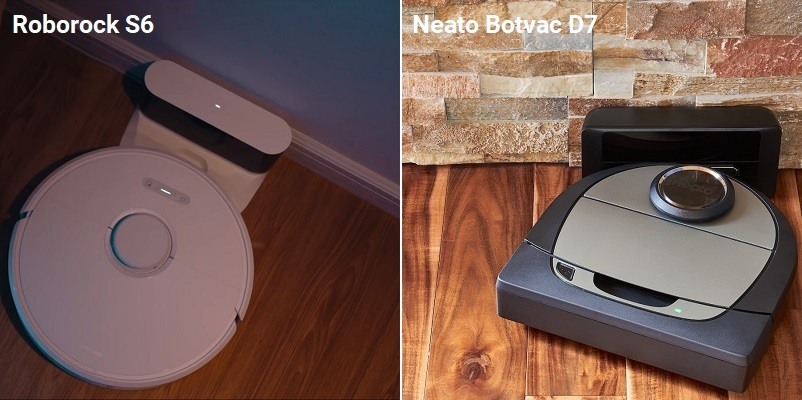
Bottom Line: This is a tie. Both robots will recharge their batteries and resume cleaning until the job is complete.
Mobile and Voice Commands
Wireless communications with robots have become the norm. It is now awkward when a robot doesn’t connect to our home networks. Both the D7 and S6 use wireless communications to enable controls through the mobile app and Alexa or Google voice commands.
Roborock falls seriously behind in the voice command arena, though. With Alexa devices, you only get two commands, either on or off. Google adds a third command, home, since the off command only stops the cleaning cycle but doesn’t return the robot to the charging station.
Neato has a lot more commands, and while it doesn’t have near as many commands as the likes of the Roomba i7+ or Roomba s9+, compared to the Roborock, it has a lot. With the voice commands, you can start, stop and resume a cleaning cycle, set a scheduled clean, and get status reports of the robot. Not bad for having to yell at a speaker box.
When it comes to mobile apps, Neato has Roborock beat, again. The app is more intuitive and user-friendly. The options are more clear, and the map display is easier to interact with. You can create a series of schedules and use digital containment (more on that below), too.
Roborock has a bit of confusion surrounding its mobile app as of the release of the S5 model. In the beginning, Roborock was a part of the Xiaomi family that worked with several companies to build a single robot. Roborock began to break away slowly and do their own thing. This included the mobile app.
The Xiaomi app will still control the Roborock robots but without all the features. Instead, the Roborock app is the one you want to download. You can find both in the app stores, so make sure you grab the right one.
The Roborock app is better than before but is still too cumbersome to be easy to use. You can do all of the control options still, such as schedules, controlling the robot, and seeing and interacting with the map. You even get virtual containment now, too.
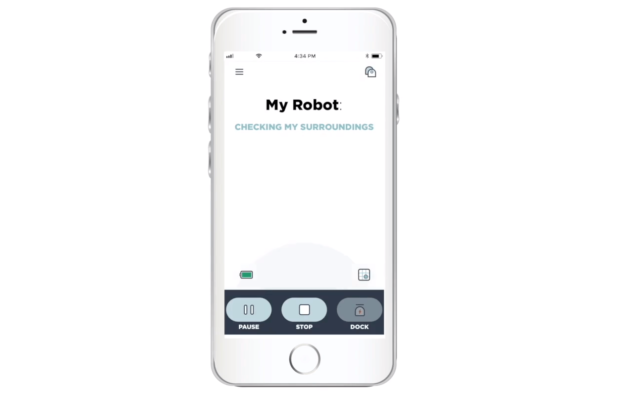
Bottom Line: Neato wins this section. The voice controls are more robust, and the mobile app is a lot more user-friendly.
Digital or Physical Containment?
When it comes to containment, Neato gives you options. The digital containment, called No-Go lines, takes your input from the map on the mobile app to know where it can and cannot go. If you want to block off a doorway or section of a room, you simply draw a line on the map and mark it as not accessible.
In the beginning, Neato had a difficult time making this feature work properly. After about 18 months and several app updates, most of the problems seem to have been worked out. If you want a more physical form of containment, you can still use the BotBoundary tape.
The tape is a magnetic strip that you cut to size and place on the floor wherever you want to prevent robot access. The D7 will approach the tape, and the magnetic sensors will alert it that the boundary has been reached.
Roborock doesn’t have physical containment. You will need to rely on closing doors and blocking off sections of your room with boxes or your baby or something. Pool noodles weighted on each end work really well, by the way.
The S6 does have its own digital containment, which is also known as No-Go lines. They work the same way. Except Roborock is now where Neato was 18 months ago. The No-Go lines don’t always work as expected, if at all.
To their credit, though, Roborock is aware of the problem and is pushing out app updates to help resolve it.
What the Roborock does have, though, is called Select Room Scheduling. You can choose a specific room on the app and pick a time for the robot to clean only that room. You can pick a single room, multiple rooms, or the entire home. Even better, when selecting multiple rooms, you can have each one cleaned at a different time. I am sure you could find a use for this feature. Maybe.
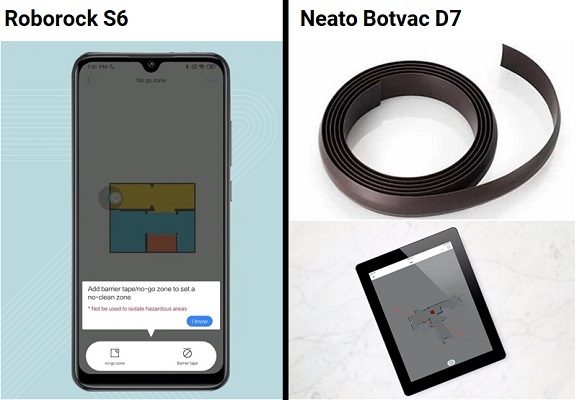
Bottom Line: Neato D7 wins. Even with a spotty record with No-Go lines and the worst possible physical containment options, they are still better than Roborock’s attempts.
Filtration at its Best
one of the commonalities is also a great thing; the filtration standards are high. Both Neato and Roborock use HEPA filters in their models, and this reduces the amount of in-home allergens you may have. Things such as dust mites, pet dander, pollen, and mold spores are all captured by the HEPA filters and not released back int the air and floors of your home.
Roborock takes the filtration one step further, and their E-11 HEPA filters are washable. You can rinse them out, remove the contaminants, and then (once dry) put back into service. This makes the filters last up to three times as long and can save you several bucks each year just in filter replacement costs.
Neato’s D7 uses the Neato Ultra, which is a HEPA filter as well. It isn’t washable, but replacement filters aren’t that expensive. You can expect to go through about three filters a year, on average. If you use the robot less than daily, you may only need to change the filter every six months.
Bottom Line: Roborock gets a slight edge with the washable filters, but both models reduce allergens and capture more particles with HEPA filters.
Extraction Methods
Both robots use a single roller for extraction. The Neato D7 has a spiral combination roller that uses a mix of soft bristles and rubber paddles. The paddles sweep hard flooring and agitate carpet while the bristles loosen debris and lift dirt into the collection chamber.
The Roborock S6 also has a combination roller with a thick bushy brush and single layers of rubber paddles. The S6 seems to sweep hard flooring a little better than the Neato D7, but lacks on carpet compared to the other robot.
Bottom Line: This is a tie. Both robots use similar rollers. The Neato is better on carpet, but the Roborock is better on hard flooring.
Mopping is Useless
[easyazon_image align=”center” height=”500″ identifier=”B07RLRWWPJ” locale=”US” src=”https://smartrobotichome.com/wp-content/uploads/2020/01/51wa4HYClOL-1.jpg” tag=”srh-easyazon-20″ width=”500″]The stand out feature of the Roborock is its ability to mop hard flooring. It has a water reservoir (0.15L capacity) that you fill with water and then attach the mopping pad. The robot runs around the home, keeping the pad wet (with either a low drip or high volume setting) and soaking it up as it moves along.
The good news is that for what it is, the mopping function works. The bad news is everything else. Before you can mop your kitchen floor, the robot must first vacuum the floor three times. After the three vacuum runs, you can then set the robot up to mop and let it run (which it does, slowly) over the floor.
The entire process, if followed correctly, will take you about 2.5 hours to clean a 12 x 12-foot area. The mop doesn’t even do that good of a job. There is zero scrubbing action, almost no pick up, and even after running the vacuum three times, there is still dirt and debris left on the floor after it is done.
All in all, you would be better off throwing a wet kitchen towel on the floor and using your foot to mop with it. Even better, use a Swiffer. It’s cleaner, faster, and does a better job.
Bottom Line: Neato can’t win because it doesn’t mop at all, which is still kind of a win.
Frequently Asked Questions
I will now attempt to answer some of the more common questions. As always, if you have other concerns, questions, or remarks, feel free to use the comment section below.
Q. What type of warranty does the Roborock S6 have?
A. Roborock comes with a 2-year limited warranty. The warranty covers all internal parts, functionality, and the battery. It does not cover replaceable parts like filters, brush rollers, side brushes, and wheels.
Q. What type of warranty does the Neato D7 offer?
A. The Neato D7 comes with a 1-year limited warranty that covers everything the robot ships with, except for replaceable parts.
Q. How do I contact Roborock customer service?
A. Currently, the only method of contact is through email. You can write to them at support@roborock.com. The better option is to use Amazon’s customer service since that is where you will make your Roborock purchases anyway. It is faster and easier than waiting for emails.
Q. Can I contact Neato customer service?
A. You can contact Neato customer service directly at 1-877-296-3286. If you would rather email or use live chat for support, you can find the addresses you need and the chat link right here.
Q. Where is the best place to buy a Roborock or Neato?
A. The only place to buy a Roborock is through Amazon unless you are in Bejing or Shenzhen, China. You currently cannot purchase through the Roborock website either, though it is rumored that this will change in late 2020. For Neato, Amazon is still the best place to make your purchase. The shipping and customer care are faster and better through Amazon, and your purchase is protected from the moment you click the buy button.
Q. What accessories will I need for these two robot vacuums?
A. You won’t need any accessories with either vacuum. Both models come with everything they have to offer. The only exception would be to buy spare parts to have on hand. Extra filters, side brushes, and a new brush roller may be handy one day, but you don’t need them right away.
What I Like About the Roborock S6
- Select Room Scheduling allows you to clean certain areas of your home at a time.
- Over 4-hours of runtime for a long-term clean.
- True wet mop for hard flooring.
What I Like About the Neato D7
- Efficient battery usage.
- Cleans all types of flooring, even medium and some high pile carpeting.
- LIDAR navigation and mapping for efficient maneuvering through your home.
Conclusion
The choice boils down to cost versus effectiveness. If you are looking to save some cash and want a robot that will perform a better-than-decent clean on your floors, the Roborock S6 is your answer. As long as you don’t put a lot of stock in the mopping aspect of the robot, you should be happy with your purchase.
If you want a better clean and don’t mind spending a little more, the Neato D7 is what you are after. With better overall performance, it is hard to find fault with the D7. Everything it does, it does well. Unless you have high pile carpeting, you won’t be disappointed at all with the Neato D7.
